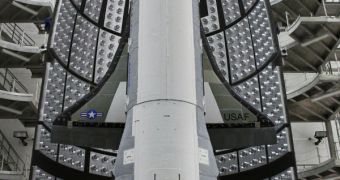According to officials with the United States Air Force (USAF), the last X-37B space plane to be launched in Earth's orbit recently exceeded the mission's 1-year milestone. This is the third of these spacecraft to be launched over the last few years on classified missions for the United States.
Speculations about what these space planes are doing in low-Earth orbit abound, and range from space weapon testbeds and orbital surveillance systems to new technology demonstrators and peaceful applications. Up until now, the USAF has kept mum about the capabilities of its new spacecraft.
The third flight of the X-37B is called the Orbital Test Vehicle 3 (OTV-3) mission, and it launched into space aboard an Atlas V rocket on December 11, 2012. Takeoff occurred from the Cape Canaveral Air Force Station (CCAFS), in Florida, located next door to the NASA Kennedy Space Center (KSC).
The spacecraft was developed from the Boeing X-40 concept, and three variants have been proposed to date. The first, X-37A, is destined primarily for use by NASA and the US Defense Advanced Research Projects Agency (DARPA), while X-37B is built specifically for the USAF.
A third variant, X-37C, was proposed by Boeing in 2011. This spacecraft would be manned, and able to carry in excess of 6 astronauts to the International Space Station and back. It would launched aboard an Atlas V Evolved Expendable Launch Vehicle, which is much larger than the standard Atlas V.
In many ways, the X-37B looks like the former space shuttles, except it is small enough to fit inside a rocket payload fairing. It measures 8.8 meters (29 feet) by 4.5 meters (15), and can hold about as much equipment and instruments as a pickup truck, Space reports.
Engineers at Boeing's Phantom Works Division, in Seal Beach, California, say that the spacecraft draws its power from a solar array that it deploys once it reaches orbit. Initially, its builders wanted to demonstrate mission durations of up to 270 days, but the first test flight, in 2010, lasted 225 days.
The second mission, OTV-2, was carried out by a different spacecraft (same variant), and lasted 469 days. These vehicles land at the Vandenberg Air Force Base, in California, once their missions are done.
However, for OTV-3, USAF officials hint at the possibility that the spacecraft might land in Florida, at the KSC's Space Shuttle Landing Strip, which is significantly longer. However, there is no way to know for sure where the vehicle will land until it actually lands.
X-37B started out as a project managed by NASA, which handed it over to DARPA in 2004 due to lack of funding. In turn, DARPA gave over the project to the USAF in 2006.

 14 DAY TRIAL //
14 DAY TRIAL //